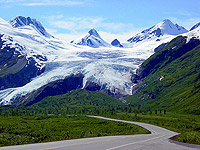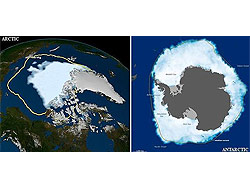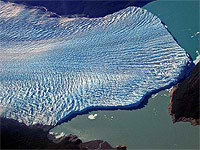    |

 |
|  | ||||||||||||||||||||||||||||||||||||||||||||||
Noticias | Terrestres | GlaciologíaLos glaciares de Alaska crecen por primera vez en 250 añosEl sorprendente frío de este verano en Alaska, unos 3 grados centígrados por debajo de la media, ha traído como resultado un aumento de los glaciares, por primera vez en 250 años. Publicado: Jueves, 27/11/2008 - 13:42 | 2312 visitas.
Unadato que coincide con el enfriamientode temperaturas en 2008yel aumentola masahelada en la Antártida. El frío de verano de Alaska ha tenido resultados sorprendentes. Por primera vez en los últimos 250 años, los glaciares han comenzado a crecer, en lugar de disminuir, en contra de las hipótesis elaboradas por los ecologistas y el Panel Intergubernamental sobre el Cambio Climático de la ONU (IPCC). El pasado verano, Alaska registró en verano una temperatura de 3 grados centígrados inferior a su media habitual, lo que permitió un incremento récord de las masas de hielo y nieve en invierno. Es decir, aumento de la masa glacial, informa Daily Tech. "A mediados de junio, sorprendió ver la nieve aún al nivel del mar en Prince William Sound", según el glaciólogo Bruce Molnia. "En general, las condiciones meteorológicas de este verano han sido las peores que he visto en al menos 20 años", según una información del Anchorage Daily News (un periódico de Alaska), recogida por el blog desdeelexilio. Desde que existen investigaciones al respecto (1946) nunca antes se había observado una acumulación de hielo como la de este año. Además, este aumento ha sido similar en otros muchos glaciares, según Molnia. Nuevas dudas sobre la influencia del hombre En este sentido, tres científicos acaban de poner de nuevo en tela de juicio el “consenso” sobre la teoría acerca del origen antropogénico (debido a la acción del hombre) del calentamiento. Según tales estudios, recogidos por este mismo blog,el actual aumento de emisiones de CO2 no sólo no contribuye al calentamiento de la tierra, sino que genera un enfriamiento. Calculan, además, que los trabajos en que se basan los informes del IPCC sobreestiman la acción (forcing) del CO2 en la temperatura en más del 2000%. Los profesores George Chilingar y Leonid Khilyuk de la “University of Southern California“, y Oleg Sorokhtin del “Institute of Oceanology of the Russian Academy of Sciences” acaban de publicar su trabajo en la revista Energy Sources.
| NoticiasImágenes
Videos
ArtículosEntradasLibros
| |||||||||||||||||||||||||||||||||||||||||||||||




 Imagen: Agencias / Internet
Imagen: Agencias / Internet





